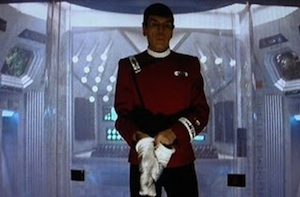In William Shakespeare’s Julius Caesar, the titular character is killed off at the end of the first act. But this doesn’t stop Caesar from getting in on the action in the second half of the play as he haunts Brutus and Marc Antony with a serious vengeance. Though coming back as a ghost is pretty great, can you imagine what would have happened if Caesar had been a character in science fiction or fantasy? I think he would have probably come back for real.
In SFF being dead is often not enough to slow someone down. But the best of these resurrections aren’t just cheap narrative tricks designed to bring back cool characters. They go the extra mile and literally revive a character that has died (or in one case, is irreversibly dying). These rebirths actually open up new directions in the development of the character and can serve to heighten the dramatic tension. Here are six of the best.
6.) The Doctor/The Master/The Time Lords (Doctor Who)
 Some sources seem to indicate Time Lords start with one heart and then grow a second one upon their first regeneration, while the existence of the Doctor’s “daughter” Jenny seems to contradict this as she starts with two hearts. In “The Deadly Assassin” it is mentioned a Time Lord can regenerate 12 times while the recent Sarah Jane Adventures episode “Death of the Doctor” asserts the Doctor can regenerate 507 times. No matter the rules, the Time Lords and Time Ladies of the planet Gallifrey are literally reborn into new beings at the moment of death. Different regenerations of Time Lords have had a host of impacts on the narrative of the stories they inhabit. One favorite theory of the Tor.com staff is that when the 9th Doctor regenerated into the 10th the resulting incarnation was heavily influenced by his love for Rose. Meaning he became more like the person he thought Rose would like during the regeneration. Romantic, right? All in all, in terms of the dramatic and bittersweet pathos, our favorite regeneration of all time is the recent transition from the 10th Doctor to the 11th Doctor. This heartbreaking moment cemented that even regenerations are a kind of death.
Some sources seem to indicate Time Lords start with one heart and then grow a second one upon their first regeneration, while the existence of the Doctor’s “daughter” Jenny seems to contradict this as she starts with two hearts. In “The Deadly Assassin” it is mentioned a Time Lord can regenerate 12 times while the recent Sarah Jane Adventures episode “Death of the Doctor” asserts the Doctor can regenerate 507 times. No matter the rules, the Time Lords and Time Ladies of the planet Gallifrey are literally reborn into new beings at the moment of death. Different regenerations of Time Lords have had a host of impacts on the narrative of the stories they inhabit. One favorite theory of the Tor.com staff is that when the 9th Doctor regenerated into the 10th the resulting incarnation was heavily influenced by his love for Rose. Meaning he became more like the person he thought Rose would like during the regeneration. Romantic, right? All in all, in terms of the dramatic and bittersweet pathos, our favorite regeneration of all time is the recent transition from the 10th Doctor to the 11th Doctor. This heartbreaking moment cemented that even regenerations are a kind of death.
5.) Spock (Star Trek)
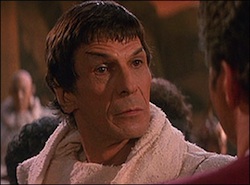 The Final Frontier isn’t remembered for being the best Star Trek film, but it does contain a great line from Bones when he says of Spock, “I liked him better before he died.”
The Final Frontier isn’t remembered for being the best Star Trek film, but it does contain a great line from Bones when he says of Spock, “I liked him better before he died.”
Famously, Spock was killed by radiation poisoning (much like the 10th Doctor) in The Wrath of Khan. Luckily, Spock stuck his katra (soul) into Bones right before he went into the dilithium chamber, thus allowing the Enterprise crew to reunite it with his Genesis-rejuvenated body in The Search for Spock. But ol’ Spock was never quite the same after that rebirth. He spends the majority of The Voyage Home trying to figure out just who the hell he is, and ultimately becomes a much warmer and friendlier guy. Maybe if Spock had never died and been brought back to life by his friends, he wouldn’t have become the peace-loving ambassador of his latter years.
Spock was always a peaceful guy, but after his whole cold utilitarian “needs of the many versus the needs of the few” maxim gets turned on its head, he seems to gradually become a more realistic person in touch with his human side. Spock coming back to life changes him from an unfeeling, sometimes arrogant person, to someone who is a little bit more understanding and says things like, “I feel fine.” You could go so far as to argue that Spock’s death and subsequent resurrection actually created the events of the latest Star Trek film, since it was a more compassionate post-Genesis Spock who was attempting to save Romulus.
4.) Jason Todd (DC Comics)
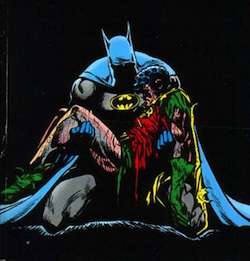 In 1988, DC Comics brutally allowed their readers to vote over the phone as to whether Dick Grayson’s successor Jason Todd would live or die. In a vote of 5,343 to 5,271 Jason got the axe and was killed by an explosion that Batman was too late to prevent. The “Death in the Family” storyline may have started as a marketing ploy, but the results it had on the Batman canon turned out some pretty great stuff. Years after his death, Jason Todd returns to Gotham City, but this time as a bad guy. Taking on the mantle of the Joker’s original alter ego, The Red Hood, Jason Todd decides to attempt to control Gotham by co-opting the criminal elements and starting a gang war.
In 1988, DC Comics brutally allowed their readers to vote over the phone as to whether Dick Grayson’s successor Jason Todd would live or die. In a vote of 5,343 to 5,271 Jason got the axe and was killed by an explosion that Batman was too late to prevent. The “Death in the Family” storyline may have started as a marketing ploy, but the results it had on the Batman canon turned out some pretty great stuff. Years after his death, Jason Todd returns to Gotham City, but this time as a bad guy. Taking on the mantle of the Joker’s original alter ego, The Red Hood, Jason Todd decides to attempt to control Gotham by co-opting the criminal elements and starting a gang war.
But how did he come back to life? In one version of the story, Superboy-Prime physically alters reality in such a way (he punches reality so hard that it flinches) that Jason finds himself back from the dead. Later, Talia al Ghul restores him completely with healing powers of her father’s infamous Lazarus pit. In the animated movie version, Batman’s old crony Ra’s al Ghul feels so bad about Jason’s death that he takes the body from the coffin, brings it to the Lazarus pit, and restores Jason to life. In both versions, coming back from the dead makes Jason totally crazy, and building upon his already troubled psyche, Jason becomes a complex and terrifying antagonist in the DC universe. This continued up through the recent Batman RIP storyline when Jason straight up decides to become a scary gun-wielding version of the famous caped-crusader. With Jason Todd, resurrection isn’t all it’s cracked up to be.
3.) Gandalf (The Lord of the Rings)
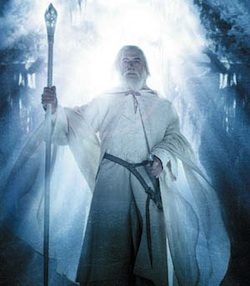 Arguably one of the best moments in the Peter Jackson adaption of The Lord of the Rings is when Gandalf falls to his death in the Mines of Moria. His selfless final words “Fly you fools!” speaks so highly about how much Gandalf loves the various people under is protection. And yet when Gandalf comes back to life as Gandalf the White in The Two Towers he doesn’t seem as warm and friendly as he was in The Fellowship of the Ring. Unlike Spock, Gandalf seems to have become colder upon resurrecting. In the first book he’s a wise old sage, in the second and third books, he’s a general commanding an army to its very probable doom.
Arguably one of the best moments in the Peter Jackson adaption of The Lord of the Rings is when Gandalf falls to his death in the Mines of Moria. His selfless final words “Fly you fools!” speaks so highly about how much Gandalf loves the various people under is protection. And yet when Gandalf comes back to life as Gandalf the White in The Two Towers he doesn’t seem as warm and friendly as he was in The Fellowship of the Ring. Unlike Spock, Gandalf seems to have become colder upon resurrecting. In the first book he’s a wise old sage, in the second and third books, he’s a general commanding an army to its very probable doom.
With Tolkien, it seems that the color a wizard indentifies with is closely tied to just how omnipotent they are about to become. When Gandalf becomes the White, he is certainly more god-like and even a little frightening at times, and we see the ultimate result of that distance in Saruman’s actions. Post-resurrection, Gandalf seems to be walking a strange kind of line between being a good guy, and just being all-powerful. It’s also interesting to note that the 11th Doctor in Doctor Who referred to himself as a “space Gandalf” in one of last season’s deleted scenes. A character that can come back from the dead and becomes a little more powerful and potentially arrogant each time? Sounds about right.
2.) John Sheridan (Babylon 5)
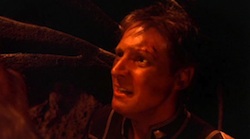 After his apparent death on Z’hadum, Captain Sheridan is granted a life extension of 20 years. This hangs over his head in a creepy way that colors all of his relationships. Like Gandalf, when Sheridan returns from the dead, he also sort of becomes creepily colder and no-nonsense. He even avoids his girlfriend Delenn, the person who he supposedly wanted to come back to life for in the first place. Several of Sheridan’s friendships fall apart after his resurrection, including his longtime acquaintance with Michael Garibaldi. However, his abilities as a military commander are at an all time high, and his sense of morality becomes crystal clear. In short, he is right and everyone else is wrong. Babylon 5 took a subtle risk with Sheridan’s rebirth. He was a likeable sort of ah-shucks sort of classic SF hero before his death. When he came back, he seemed that way on the surface, but there was suddenly something way more calculating about it. Unlike Kirk or Picard in Star Trek, Sheridan wasn’t even contemplating some of his more extreme decisions. He was just forging ahead without looking back. This was great storytelling as it demonstrated how similar he was becoming to the uber-powerful and frightening alien races; the Vorlons and the Shadows.
After his apparent death on Z’hadum, Captain Sheridan is granted a life extension of 20 years. This hangs over his head in a creepy way that colors all of his relationships. Like Gandalf, when Sheridan returns from the dead, he also sort of becomes creepily colder and no-nonsense. He even avoids his girlfriend Delenn, the person who he supposedly wanted to come back to life for in the first place. Several of Sheridan’s friendships fall apart after his resurrection, including his longtime acquaintance with Michael Garibaldi. However, his abilities as a military commander are at an all time high, and his sense of morality becomes crystal clear. In short, he is right and everyone else is wrong. Babylon 5 took a subtle risk with Sheridan’s rebirth. He was a likeable sort of ah-shucks sort of classic SF hero before his death. When he came back, he seemed that way on the surface, but there was suddenly something way more calculating about it. Unlike Kirk or Picard in Star Trek, Sheridan wasn’t even contemplating some of his more extreme decisions. He was just forging ahead without looking back. This was great storytelling as it demonstrated how similar he was becoming to the uber-powerful and frightening alien races; the Vorlons and the Shadows.
1.) Voldemort (Harry Potter series)
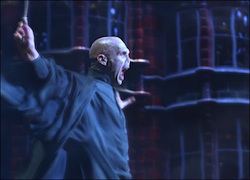 By just being a pure little ball of baby-wizard goodness, Harry Potter manages to kill the dark lord Voldemort. Being famously fearful of death, Voldemort enacts several backup plans designed to bring his slithery self to life. J.K. Rowling’s entire epic series relies exclusively on the concept of his belabored resurrection. Though there are a myriad of other plot threads in the Potter series, the core story is about Voldemort versus Harry. The lack of a physical body and the various, complex attempts at resurrection on the part of the dark lord make up the basic plot of almost every single book.
By just being a pure little ball of baby-wizard goodness, Harry Potter manages to kill the dark lord Voldemort. Being famously fearful of death, Voldemort enacts several backup plans designed to bring his slithery self to life. J.K. Rowling’s entire epic series relies exclusively on the concept of his belabored resurrection. Though there are a myriad of other plot threads in the Potter series, the core story is about Voldemort versus Harry. The lack of a physical body and the various, complex attempts at resurrection on the part of the dark lord make up the basic plot of almost every single book.
The nice thing about Voldemort’s resurrection is that unlike most SFF rebirths, it’s one that you don’t ever want to have happen, but you know is coming anyhow. It’s a solid achievement on the part of Rowling that in a world where people are doing all sorts of unnatural things the notion of cheating death is treated as the purest evil.
Ryan Britt is a staff blogger for Tor.com. If he is ever regenerated, or reborn, he’d like to come back as a talking dinosaur.










